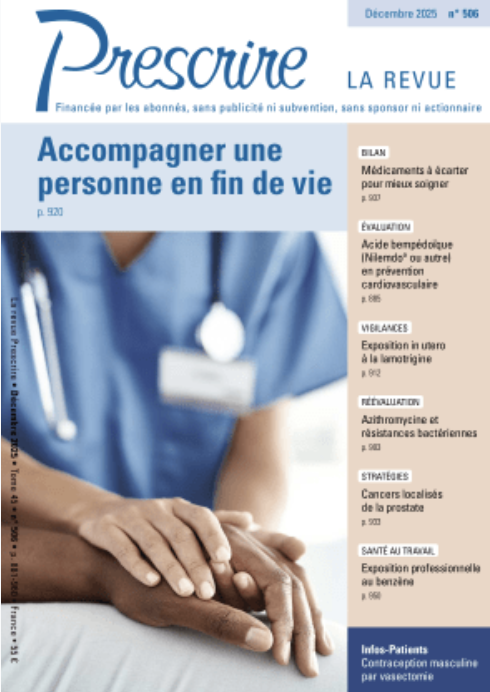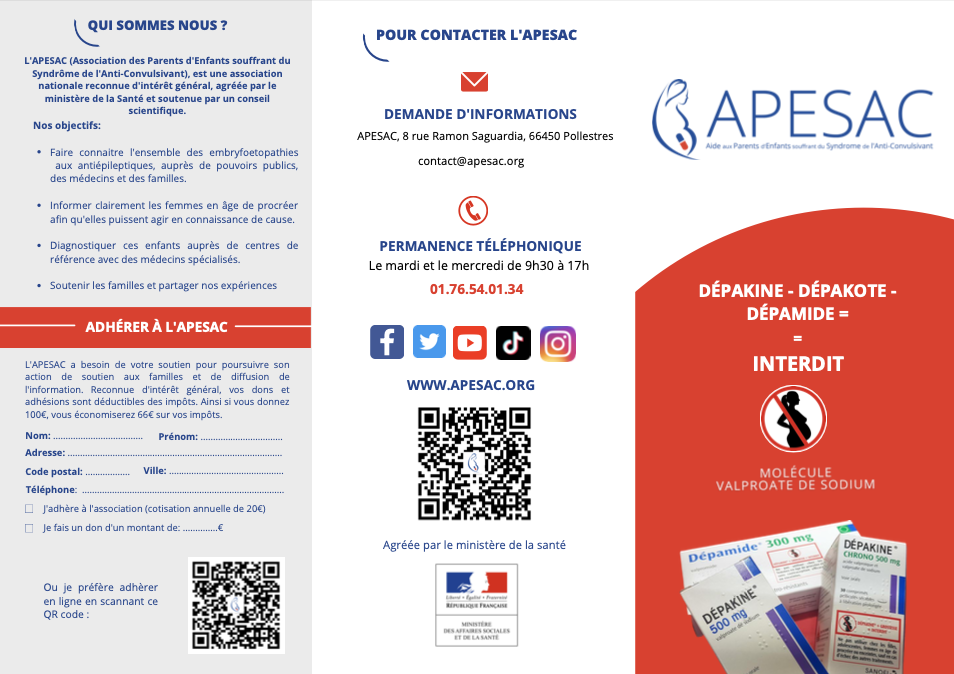HealthSense
I was a young parent when I made the connection between the drug I took to treat my epilepsy and my children’s disabilities. It began when my eldest child was diagnosed with a range of developmental and learning disabilities at the age of three. When I started researching possible factors that might have caused them, I was horrified to find similarities between my son’s condition and the clinical description of ‘fetal valproate syndrome’, which can affect children born to mothers treated during pregnancy with valproate, a drug used to control epileptic seizures. As I am epileptic, I had been prescribed valproate in the form of drugmaker Sanofi’s anti-epileptic marketed here in France under the name Dépakine. Now both of my children have been diagnosed with the syndrome. No health professionals had thought to ask questions after one, and then both, of my children showed problems. It was down to me to make the connection.
Determined to expose the problem, in 2011 I started APESAC, the French association that supports parents of children with fetal valproate syndrome. As president of APESAC I represent more than 8,000 French victims in front of public authorities and courts.
The potential for valproate drugs to harm the growing fetus has been known since 1982. Ten per cent of babies exposed to valproate during pregnancy are born with birth defects, and 40% are at risk of developmental disorders.(1) Yet, despite many meetings and reports, no action seems to have been taken in France until my legal case went public in 2015.(2,3)
A tick-box exercise?
Today I’m a patient expert at the French Medicines Agency and the European Medicines Agency (EMA). But is this really a step forward? We wonder whether the existence of ‘patient experts’ is just a tick-box exercise,(4) because we continue to find that patient representatives are left out of the design of important initiatives, such as the Stakeholder Safety Engagement Tool which was produced by the Pharmacovigilance Risk Assessment Committee of the European Medicines Agency in 2021. Further, funding to provide the support, training and structuring that would help patients participate effectively tends to be overlooked. I was also recently excluded by the French Health Agency from discussions and decisions concerning the re-evaluation of the pregnant woman pictogram on drugs boxes – the irony being that I am the one whose campaign had ensured that they are now included on packaging for all teratogenic drugs.
APESAC’s relentless whistleblowing has resulted in some genuine new safeguards, in our country at least. In France in 2015 our actions led to restrictions similar to those used for the acne drug Isotretinoin – that is, now valproate and its by-products may only be prescribed to women of childbearing age by specialists, who must obtain their patient’s signed informed consent. And, as mentioned above, we also called for ‘Danger’ or ‘Forbidden’ pictograms to be added to the drugs’ packaging. This was implemented in October 2017.(5)
Data sharing refused
The above measures relate to the dangers that are now well known. But there are others.
For example, there is some evidence of harms to children whose fathers were taking valproate before conception. In 2017 APESAC called for an investigation into men prescribed valproate and the consequences on their children. The EMA commissioned a study to be conducted by Sanofi, who in turn delegated it to a Contract Research Organization.
The study is now complete, and the initial results may indeed indicate an increased risk of neurodevelopmental disorders in children born to men taking valproate in the three months before conception. However the data is currently being reanalysed over methodology concerns and a question over possible errors in the database.(6) APESAC and its scientific council have accordingly requested access to the data to the EMA in order to verify that a part of the population hasn’t been excluded and that there’s no methodological error. We want to be sure that the evidence is robust. But to date, the EMA has refused to release the information, despite our using the services of a lawyer to appeal.
Another area in which we have called for more research is in the possibility that valproate harms could be passed on to future generations. Our calls to the French government for studies into transgenerational effects of valproate have, however, fallen on deaf ears. We were told to go away and do our own research. Scandalized by the government’s disregard for their citizen’s health, we took up their suggestion. Among our membership we have many valproate children who are now adults, and they are worried about the prospect of parenthood. They need answers. So, in 2022 I took part in a study that looked at whether valproate syndrome could go on to harm future generations.
Harms across generations
We questioned 108 parents who themselves had suffered complications due to exposure to the drug in utero. We found that fewer than half of the valproate-harmed children interviewed went on to have healthy children themselves. Twenty-three per cent of the second-generation babies had been born with physical malformations – some to hands and feet, others with spina bifida, heart conditions or kidney problems; while 44% had neurodevelopmental disorders such as psychomotor problems or autism. So, it would seem that the harms of prenatal valproate exposure are indeed transgenerational.(7) This study was conducted without the support of the French Ministry of Health, who had not acted on my early warning. We continue to call for individuals who had been exposed to valproate in utero to be informed of this risk, so they can consider fertility options, antenatal diagnosis and adequate early surveillance.
In pursuit of justice for valproate-harmed people, I have relied on our media activities to exert pressure on our Ministry of Health and the EMA to ensure that the safety measures are applied effectively. Unfortunately, this seems to be the only way to be heard, because I am just a mother and a patient, and have repeatedly felt scorned by the authorities for that.
I have also pursued legal proceedings to raise awareness of the issues. We have, however, encountered inertia from the public authorities and from Sanofi when it comes to updating patient information leaflets in line with current scientific knowledge of the dangers. Sanofi have been slow to acknowledge their responsibilities with respect to their anti-epileptic drug’s harms and to compensate the victims. While a compensation scheme exists, since 2018 any support for parents has come from the French state. I applied personally to the company for compensation in 2016, but was refused.
EMA slow to act
Compared to the UK, the problem is worse in France. In the year 2021, more than 220 children born here were affected by exposure to valproate. By comparison, in the UK only 17 valproate-affected children were born in the six months between October 2021 and March 2022. So clearly the current measures in France are not sufficient to limit the number of valproate-harmed pregnancies.
Since the UK left the European Union, the EMA has been slow to take decisions. In the UK, new restrictions were introduced for the prescribing of valproate from 31 January 2024, including the requirement for two specialists to sign off on prescriptions for both men and women aged under 55.(1) I have asked for this double prescribing to be made compulsory in France, too. Unfortunately, the EMA seen unwilling to take action in response to the accumulating evidence. I now hope that the French Medicines Agency will bypass the EMA and take their own steps to promote patient safety, and I’m working to make sure that happens.
Valproate could be the tip of the iceberg. The issue of fetal abnormalities linked to drug use in pregnancy is not restricted to anti-seizure medications.(8) Antidepressants are the most prescribed drug during pregnancy and recent work finds that these, too, may affect brain development in utero.( 9,10)
The late Andrew Herxheimer, who was a long-standing member of the HealthSense committee, wisely crusaded for the role of patients in pharmacovigilance.(11) Sadly we still have a long way to go. We need to do more than simply collect data on personal harms to patients, we need to ensure patients are protected by law. Indeed, pharmacovigilance seems to have a systemic issue of inertia. Why do so many drug industry stakeholders and, specifically, the European Medicines Agency, feel they can by-pass the principle to ‘first do no harm’? Certainly the work of the regulatory agencies is challenging but clearly they fail to act in due time to protect the interests of the patients.(12) In whose interests is that?
Marine Martin
President, APESAC, France
References
- Epilepsy Society. New prescribing practices for valproate. 20 November 2023. Available online: https://epilepsysociety.org.uk/news-changes-valproate
- Braillon A, Bewley S. Prescribing in pregnancy shows the weaknesses in pharmacovigilance. BMJ. 2018;361:k2334. Published 2018 May 29. doi:10.1136/bmj.k2334
- Braillon A, Martin M. Epigenetic and translational psychology: admitting mistakes is not a weakness but a prerequisite for scaling up. Psychol Med. 2023;53(10):4829-4830. doi:10.1017/S0033291722001465
- Braillon A, Martin M. Comment on: « Proposals for Engaging Patients and Healthcare Professionals in Risk Minimisation from an Analysis of Stakeholder Input to the EU Valproate Assessment Using the Novel Analysing Stakeholder Safety Engagement Tool (ASSET) ». Drug Saf. 2021;44(9):1007-1009. doi:10.1007/s40264-021-01101-y
- Order National des Pharmaciens. Médicaments et grossesse : un pictogramme pour améliorer l’information sur les risques. 13/10/2017 Available online: https://www.ordre.pharmacien.fr/les-communications/focus-sur/les-actualites/medicaments-et-grossesse-un-pictogramme-pour-ameliorer-l-information-sur-les-risques
- European Medicines Agency. EMA review of data on paternal exposure to valproate. 16 August 2023. Available online: https://www.ema.europa.eu/en/news/ema-review-data-paternal-exposure-valproate
- Martin M, Hill C, Bewley S, MacLennan AH, Braillon A. Transgenerational adverse effects of valproate? A patient report from 90 affected families. Birth Defects Res. 2022;114(1):13-16. doi:10.1002/bdr2.1967
- Braillon A. Neurodevelopmental disorders after prenatal exposure to topiramate: A lost decade idly watching from the sidelines. Seizure. 2023;107:190-191. doi:10.1016/j.seizure.2023.03.009
- Braillon A. Association of Maternal Antidepressant Prescription During Pregnancy and Danish School-aged Children’s Standardized Test Scores. JAMA. 2022;327(8):781-782. doi:10.1001/jama.2021.24739
- Braillon A, Bewley S, Blumsohn A, Naudet F, Montastruc JL, Lexchin JR. Antidepressants are not safe during pregnancy and in women of child-bearing age. Br J Clin Pharmacol. 2022;88(5):2447-2448. doi:10.1111/bcp.15142
- Ziebland S, Herxheimer A. How patients’ experiences contribute to decision making: illustrations from DIPEx (personal experiences of health and illness). J Nurs Manag. 2008;16(4):433-439. doi:10.1111/j.1365-2834.2008.00863.x
- Braillon A, Menkes DB. Balancing Accelerated Approval for Drugs With Accelerated Withdrawal. JAMA Intern Med. 2016;176(4):566-567. doi:10.1001/jamainternmed.2016.0351






